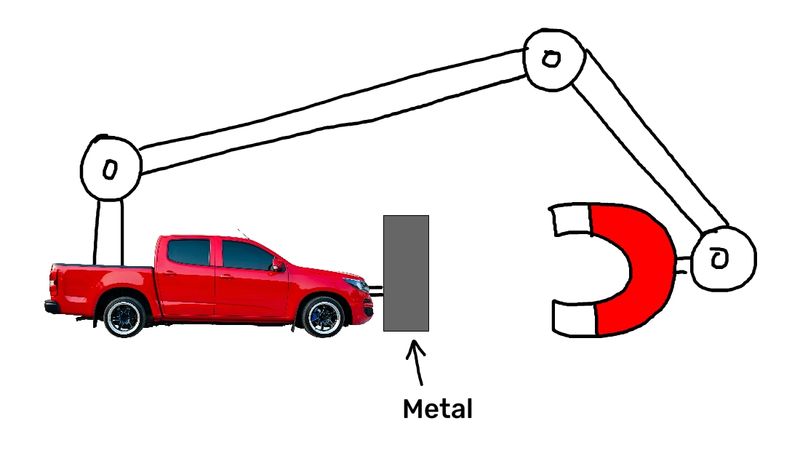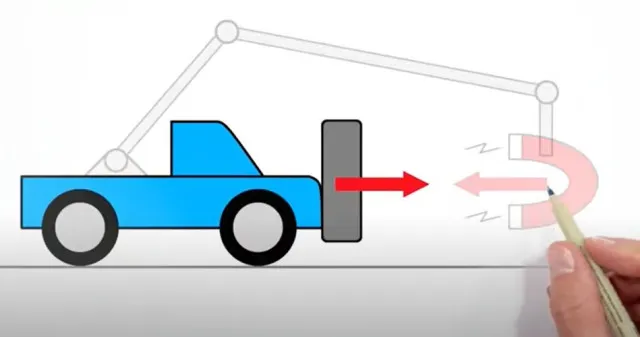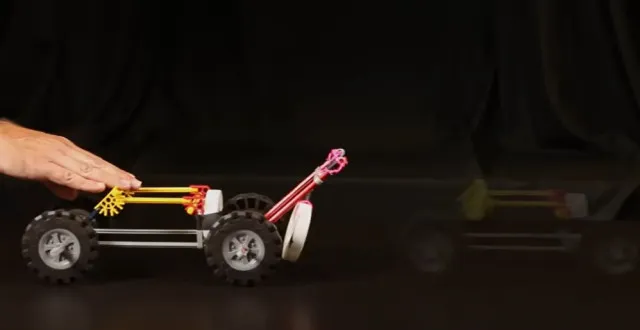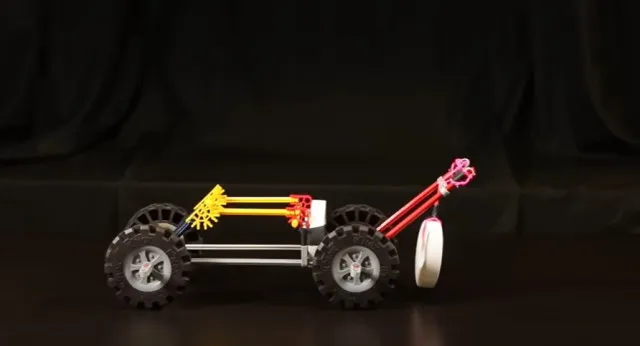The idea of a magnet-powered truck has sparked a wave of curiosity and debate on social media, particularly after a tweet from @NoContextHumans asked, “Give me one reason why this wouldn’t work.” The concept seems simple enough: why not attach a magnet to the front of a truck and use another magnet to propel it forward? While the idea has intrigued many, including those without a deep understanding of physics, the answer to why it won’t work lies in the fundamental laws of physics.
The Magnet Truck That Broke the Internet

It didn’t take long for Twitter to light up with discussions and theories surrounding the magnet truck. Many users expressed their fascination with the concept and admitted their confusion about why it wouldn’t work. The post’s comment section quickly filled with witty remarks, with one person jokingly stating, “Physicists have been suspiciously quiet since this dropped,” while another said, “This is like pulling your own shirt to try and make yourself move.”
While these comments provided some humor, they also highlighted a common misunderstanding about how magnets work and why they can’t be used to power vehicles in the way people imagine.
The Basics of Magnetism and Motion
To understand why the magnet truck won’t work, we need to start with the basics of magnetism. Magnets generate a magnetic field, and they exert attractive or repulsive forces depending on the poles involved—opposite poles attract, and like poles repel. It’s these forces that make magnets so fascinating, as they appear to exert influence without any physical contact.
However, when it comes to using magnets to power vehicles, things get tricky. The idea that attaching a magnet to a truck and using another magnet to pull or push it forward seems plausible at first glance, but there’s one major problem: the magnets are part of the same system. In a closed system like this, the magnets can interact with each other, but they won’t create the external force needed to move the truck.
Newton’s Laws of Motion: The Key Reason It Fails
The primary reason why the magnet truck concept doesn’t work lies in Newton’s laws of motion, specifically the First and Third Laws.
- Newton’s First Law: An object at rest remains at rest unless acted upon by an external force.In the case of the magnet truck, both the truck and the magnets are part of the same system. For the truck to move, there needs to be an external force applied to it. Simply moving a magnet within the same system does not count as an external force.
- Newton’s Third Law: For every action, there is an equal and opposite reaction.In the magnet truck example, the magnet attached to the truck pulls or repels the other magnet, but because they are part of the same system, the forces cancel each other out. No movement occurs because the magnets exert forces on each other, but not on an external object.
This concept is akin to the idea of trying to push a car from the inside. If your car breaks down and you try to push it while sitting inside, it won’t move. This is because no external force is being applied to the car—it’s a closed system. Similarly, the magnets on the truck can’t apply an external force to make the truck move forward.
The Perpetual Motion Machine Myth

Another reason the magnet truck concept fails is that it would essentially be a form of a perpetual motion machine—a device that could move indefinitely without an external energy source. Perpetual motion machines are impossible under the laws of physics because they violate the conservation of energy.
In any system, energy is either consumed or lost due to factors like friction and resistance. In the case of a magnet truck, even if the magnets could generate some form of motion, energy would be required to sustain it, which would lead to a need for constant energy input. Without an external power source, the truck would come to a stop.
Perpetual motion machines are often the subject of impossible inventions and have been thoroughly debunked by physicists over the centuries. The magnet truck falls into the same category—without an external energy source, it cannot generate continuous motion.
Understanding External Forces: Why They’re Crucial for Movement
Let’s simplify this further by imagining a rubber band stretched in front of a vehicle. If you’re standing outside the car and pulling the rubber band, you’re creating an external force that could move the car forward. Now, imagine trying to pull the rubber band from inside the car’s sunroof. In this scenario, no movement would occur because no external force is being applied.

The same principle applies to the magnet truck. The magnets are part of the same system, and thus no external force is being applied to propel the truck forward.
Why Magnets Aren’t Used for Vehicle Propulsion
While magnets have many practical uses—ranging from electrical generators to medical devices—they aren’t viable for vehicle propulsion. Cars rely on fuel or electricity to create movement because these energy sources provide the external force necessary to overcome friction and resistance, driving the vehicle forward.
Magnets, in contrast, don’t offer a reliable way to sustain movement, especially in a system where they are both the force and the object being acted upon. In short, the magnet truck concept might seem clever, but it doesn’t work within the framework of known physics.
A Fun Thought Experiment, But Not a Practical Solution

The idea of a magnet-powered truck is undoubtedly fun to think about, and it’s sparked plenty of creative discussions online. However, as much as we might wish for a groundbreaking discovery, the reality is that the concept falls apart when examined through the lens of science. Magnetism, while powerful, cannot create the external force required to move a vehicle without outside energy input.
Conclusion: The Magnet Truck and the Laws of Physics
The magnet truck concept has captured the imagination of many on social media, but it ultimately fails due to fundamental laws of motion and the reality of how energy works. Newton’s laws make it clear that external forces are required to move objects, and magnets alone cannot fulfill that requirement in a closed system like a truck.
While it’s fun to speculate and brainstorm creative solutions to old problems, this is one case where science sets clear boundaries. So, the next time you hear about a magnet-powered vehicle, you can confidently explain why it won’t work—and impress your friends with your knowledge of physics in the process.


